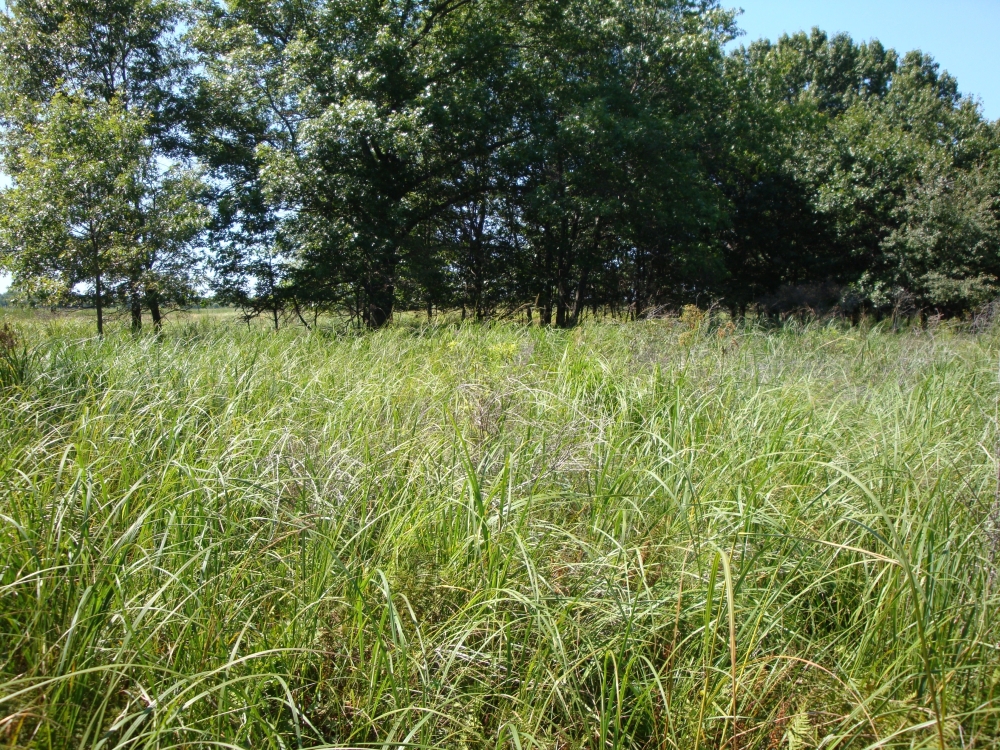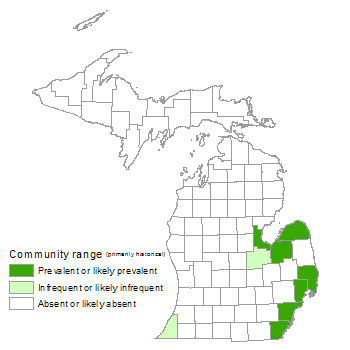Lakeplain Wet Prairie
Overview
Lakeplain wet prairie is a species-rich prairie community that occurs on the seasonally wet ground of glacial lakeplains in the southern Great Lakes region. The community occurs along the shoreline of Lake Huron in Saginaw Bay, within the St. Clair River Delta, and near Lake Erie. Seasonal flooding, cyclic changes in Great Lakes water levels, beaver flooding, and fire historically maintained the species composition and community structure of lakeplain wet prairies.
Rank
Global Rank: G2 - Imperiled
State Rank: S1 - Critically imperiled

Landscape Context
Lakeplain wet prairie occurs on level, sandy glacial lakeplains and deposits of dune sand in silt/clay glacial lakeplains. Historically, the mosaic of sand deposits and thin mineral soil on clay glacial lakeplains supported a patchwork of natural communities such as lakeplain wet prairie, lakeplain wet-mesic prairie, lakeplain oak openings, wet-mesic flatwoods, and southern hardwood swamps. Lakeplain wet prairie often occupies a transition zone between emergent marsh or Great Lakes marsh and lakeplain wet-mesic prairie.
Soils
Soils are medium- to fine-textured, slightly acid to moderately alkaline sands, sandy loams, or silty clays with poor to moderate water-retaining capacity.
Natural Processes
Lakeplain prairies typically experience seasonal flooding and include small pockets that remain wet throughout the year. Glacial lakeplains that support wet prairies often have a clay layer positioned below one to three meters of highly permeable sand. The clay layer both impedes drainage and prevents groundwater from moving to the surface, resulting in temporary flooding in the winter and spring and drought in summer and fall. Extreme variation in soil moisture regime limits establishment of woody vegetation. Vegetation composition and structure of lakeplain wet prairies are also affected by cyclic changes in Great Lakes water levels, which influence the regional water table.
Other factors that influence the development and maintenance of lakeplain wet prairies include beaver activity and periodic wildfire. Prolific beaver activity in the flat lakeplain landscape may have contributed to the extensive wet prairies that were known from pre-European settlement. The combination of accumulated organic material and drought conditions during the late growing season made lakeplain prairies prone to lightning- and Native American-induced wildfires.
Vegetation
The vegetation of lakeplain wet prairies is moderately dense with little exposed bare ground. Vegetation height averages one to two meters. The community is dominated by graminoids, but is extremely diverse, with as many as 200 plant species found within a single prairie remnant. Characteristic plants include bluejoint grass (Calamagrostis canadensis), cordgrass (Spartina pectinata), Baltic rush (Juncus balticus), sedges (Carex stricta, Carex pellita, and C. aquatilis), twig-rush (Cladium mariscoides), swamp milkweed (Asclepias incarnata), and shrubby cinquefoil (Dasiphora fruticosa).
For information about plant species, visit the Michigan Flora website.
Plant Lists
Graminoids
- big bluestem (Andropogon gerardii)
- blue-joint (Calamagrostis canadensis)
- sedges (Carex aquatilis, C. aurea, C. buxbaumii, C. diandra, C. pellita, C. prairea, C. stricta, and others)
- twig-rush (Cladium mariscoides)
- fowl manna grass (Glyceria striata)
- rushes (Juncus balticus, J. canadensis, J. dudleyi, J. tenuis, J. torreyi, and others)
- switch grass (Panicum virgatum)
- common reed (Phragmites australis subsp. americanus)
- threesquare (Schoenoplectus pungens)
- Indian grass (Sorghastrum nutans)
- cordgrass (Spartina pectinata)
Forbs
- purple false foxglove (Agalinis purpurea)
- swamp agrimony (Agrimonia parviflora)
- Canada anemone (Anemone canadensis)
- swamp milkweed (Asclepias incarnata)
- hedge bindweed (Calystegia sepium)
- water hemlock (Cicuta bulbifera)
- swamp thistle (Cirsium muticum)
- common boneset (Eupatorium perfoliatum)
- grass-leaved goldenrod (Euthamia graminifolia)
- joe-pye-weed (Eutrochium maculatum)
- sneezeweed (Helenium autumnale)
- southern blue flag (Iris virginica)
- marsh blazing-star (Liatris spicata)
- pale spiked lobelia (Lobelia spicata)
- whorled loosestrife (Lysimachia quadriflora)
- winged loosestrife (Lythrum alatum)
- common mountain mint (Pycnanthemum virginianum)
- common skullcap (Scutellaria galericulata)
- goldenrods (Solidago gigantea, S. ohioensis, S. riddellii, and others)
- nodding ladies’-tresses (Spiranthes cernua)
- asters (Symphyotrichum lanceolatum and others)
- purple meadow-rue (Thalictrum dasycarpum)
- Culver’s root (Veronicastrum virginicum)
- golden alexanders (Zizia aurea)
Shrubs
- dogwoods (Cornus spp.)
- shrubby cinquefoil (Dasiphora fruticosa)
- Kalm’s St. John’s-wort (Hypericum kalmianum)
- willows (Salix spp.)
Noteworthy Animals
Beaver can cause flooding that substantially alters wetland community structure, converting lowland shrub and forest systems to pond, emergent marsh, wet meadow, lakeplain wet prairie, and lakeplain wet-mesic prairie depending on landscape position, soils, and depth and duration of flooding.
Rare Plants
- Agalinis gattingeri (Gattinger’s gerardia, state endangered)
- Agalinis skinneriana (Skinner’s gerardia, state endangered)
- Arabis missouriensis var. deamii (Missouri rock-cress, state special concern)
- Aristida longespica (three-awned grass, state threatened)
- Asclepias hirtella (tall green milkweed, state threatened)
- Asclepias purpurascens (purple milkweed, state special concern)
- Asclepias sullivantii (Sullivant’s milkweed, state threatened)
- Aster praealtus (willow aster, state special concern)
- Cacalia plantaginea (prairie Indian-plantain, state special concern)
- Carex festucacea (fescue sedge, state special concern)
- Cypripedium candidum (white lady’s-slipper, state threatened)
- Eleocharis engelmannii (Engelmann’s spike-rush, state special concern)
- Fimbristylis puberula (chestnut sedge, presumed extirpated from Michigan)
- Hypericum gentianoides (gentian-leaved St. John’s-wort, state special concern)
- Juncus vaseyi (Vasey’s rush, state threatened)
- Leucospora multifida (conobea, state special concern)
- Ludwigia alternifolia (seedbox, state special concern)
- Lycopodiella margueriteae (northern prostrate clubmoss, state special concern)
- Lycopodiella subappressa (northern appressed bog clubmoss, state special concern)
- Mimulus alatus (wing-stemmed monkey-flower, presumed extirpated from Michigan)
- Panicum polyanthes (round-seed panic grass, state endangered)
- Platanthera leucophaea (prairie fringed orchid, federal threatened and state endangered)
- Polygala cruciata (cross-leaved milkwort, state special concern)
- Polygala incarnata (sand milkwort, state threatened)
- Potentilla paradoxa (sand cinquefoil, state threatened)
- Scirpus clintonii (Clinton’s bulrush, state special concern)
- Scleria pauciflora (few-flowered nut-rush, state endangered)
- Scleria triglomerata (tall nut-rush, state special concern)
- Sisyrinchium farwellii (Farwell’s blue-eyed-grass, presumed extirpated from Michigan)
- Spiranthes ochroleuca (yellow ladies’-tresses, state special concern)
Rare Animals
- Ammodramus savannarum (grasshopper sparrow, state special concern)
- Asio flammeus (short-eared owl, state endangered)
- Botaurus lentiginosus (American bittern, state special concern)
- Circus cyaneus (northern harrier, state threatened)
- Clemmys guttata (spotted turtle, state threatened)
- Dorydiella kansana (leafhopper, state special concern)
- Elaphe vulpine gloydi (eastern fox snake, state threatened)
- Flexamia delongi (leafhopper, state special concern)
- Flexamia reflexus (leafhopper, state special concern)
- Gastrocopta holzingeri (lambda snaggletooth snail, state special concern)
- Neoconocephalus lyrists (bog conehead, state special concern)
- Neoconocephalus retusus (conehead grasshopper, state special concern)
- Orchelimum concinnum (red-faced meadow katydid, state special concern)
- Orchelimum delicatum (delicate meadow katydid, state special concern)
- Orphulella pelidna (green desert grasshopper, state special concern)
- Papaipema beeriana (blazing star borer, state special concern)
- Phalaropus tricolor (Wilson’s phalarope, state special concern)
- Rallus elegans (king rail, state endangered)
- Spiza americana (dickcissel, state special concern)
- Tyto alba (barn owl, state endangered)
Biodiversity Management Considerations
Since the 1800s, there has been extensive loss and degradation of lakeplain wet prairies due to conversion to agriculture, residential and industrial development, alterations of groundwater hydrology, and fire suppression. It is estimated that less than 1% of the original community remains. Therefore, protection and restoration of existing prairie remnants is a top conservation priority.
Threats to remaining sites include hydrologic alteration, nutrient enrichment, siltation, fire suppression, shrub and tree encroachment, and destruction of upland buffers. Fire suppression and hydrologic alterations such as ditching and tiling promote shrub and tree invasion, which results in reduced cover of graminoids and the fine-fuels needed to carry a fire. Invasive plants are favored by nutrient enrichment, fire suppression, and hydrologic alteration. Invasive species that threaten the diversity and community structure of lakeplain wet prairie include glossy buckthorn (Frangula alnus), multiflora rose (Rosa multiflora), autumn olive (Elaeagnus umbellata), reed (Phragmites australis subsp. australis), reed canary grass (Phalaris arundinacea), narrow-leaved cat-tail (Typha angustifolia), hybrid cat-tail (Typha xglauca), and purple loosestrife (Lythrum salicaria). Prescribed fire, in conjunction with cutting and/or herbiciding of invasive species, can be used to maintain biodiversity of lowland grasslands. Some sites may require hydrologic restoration and efforts to restrict nutrient and sediment inputs. In addition, restoration of upland natural communities bordering lakeplain wet prairie occurrences should be conducted to improve hydrology and provide refugia for flood-intolerant species during periods of high water.
Variation
Species composition is influenced by depth and duration of seasonal flooding and proximity to other wetland communities.
Similar Natural Communities
Lakeplain wet-mesic prairie, wet prairie, wet-mesic prairie, wet-mesic sand prairie, southern wet meadow, Great Lakes marsh, and emergent marsh.
Places to Visit
- Killarney Beach, Bay City State Recreation Area, Bay Co.
- Sebewaing Bay, Fish Point State Game Area, Tuscola Co.
Relevant Literature
- Albert, D.A., D.L. Cuthrell, D.A. Hyde, J.T. Legge, M.R. Penskar, and M.L. Rabe. 1996. Sampling and management of lakeplain prairies in southern Lower Michigan. Michigan Natural Features Inventory, Lansing, MI. 93 pp.
- Albert, D.A., and M.A. Kost. 1998. Natural community abstract for lakeplain wet prairie. Michigan Natural Features Inventory, Lansing, MI. 4 pp.
- Comer, P.J., W.A. MacKinnon, M.L. Rabe, D.L. Cuthrell, M.R. Penskar, and D.A. Albert. 1995. A survey of lakeplain prairie in Michigan. Michigan Natural Features Inventory, Lansing, MI. 232 pp.
- Hayes, B.N. 1964. An ecological study of wet prairie on Harsens Island, Michigan. Michigan Botanist 3: 71-82.
- Faber-Langendoen, D., and P.F. Maycock. 1987. Composition and soil-environment analysis of prairies on Walpole Island, southwestern Ontario. Canadian Journal of Botany 65: 2410-2419.
- Jones, C.L., and R.O. Kapp. 1972. Relationship of Bay County Michigan presettlement forest patterns to Indian cultures. Michigan Academician 5: 17-28.
- Minc, L.D. 1995. Seasonal hydrology and species relationships in Lower Michigan’s lakeplain prairies. An analysis and report submitted to Michigan Natural Features Inventory. 89 pp.
For a full list of references used to create this description, please refer to the natural community abstract for Lakeplain Wet Prairie.
More Information
Citation
Cohen, J.G., M.A. Kost, B.S. Slaughter, D.A. Albert, J.M. Lincoln, A.P. Kortenhoven, C.M. Wilton, H.D. Enander, and K.M. Korroch. 2020. Michigan Natural Community Classification [web application]. Michigan Natural Features Inventory, Michigan State University Extension, Lansing, Michigan. Available https://mnfi.anr.msu.edu/communities/classification. (Accessed: November 14, 2025).
Kost, M.A., D.A. Albert, J.G. Cohen, B.S. Slaughter, R.K. Schillo, C.R. Weber, and K.A. Chapman. 2007. Natural Communities of Michigan: Classification and Description. Michigan Natural Features Inventory, Report No. 2007-21, Lansing, MI.


